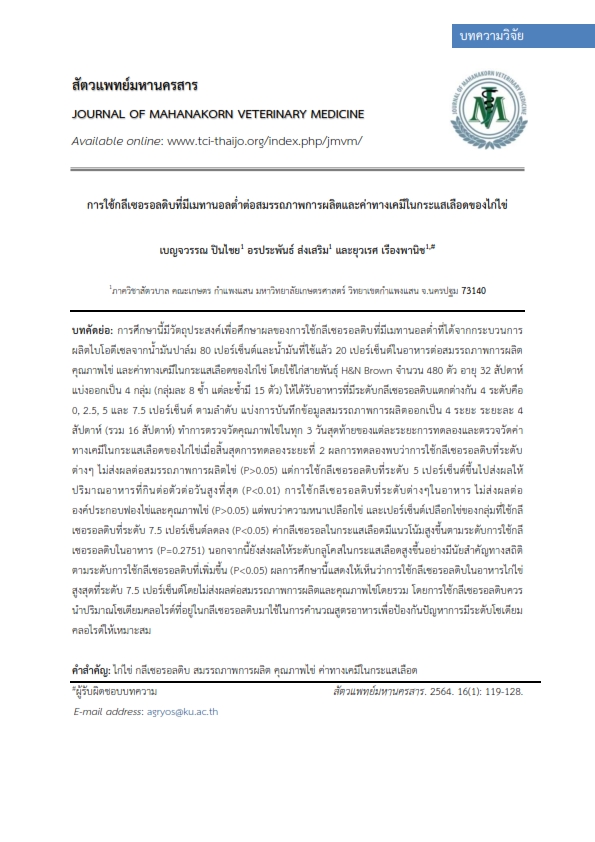The Utilization of Crude Glycerol with Low Methanol Content on Production Performance and Blood Chemistry of Laying Hens
Main Article Content
Abstract
The experiment was conducted to determine the utilization of crude glycerol with low methanol content on production performance and blood chemistry of laying hens. A total of 480 laying hen, 32 WOA H&N Brown were divided into 4 dietary treatments (8 replications with 15 birds each) including 0, 2.5, 5 and 7.5 % crude glycerol respectively. Production performance was recorded for 4-4 weeks periods (a total of 16 weeks). Egg quality measurement was performed for the last 3 consecutive days of each period. Blood chemistry was analyzed at the end of period 2. There was no significant difference on production performance and egg quality among dietary treatments (P>0.05). However, using crude glycerol ≥ 5 % decreased average feed intake of laying hen (P<0.01). The use of crude glycerol at 7.5 % decreased eggshell thickness, % eggshell weight and yolk color (P<0.05). An increase in the level of crude glycerol in the diet numerically increased blood glycerol (P=0.2751) and significantly increased the level of blood glucose (P<0.05). From the present study, crude glycerol could be incorporated in laying hens diets up to 7.5 % without causing any negative effect of egg production and egg quality. However, the levels of sodium chloride in crude glycerol should be using to formulate the diet to obtain suitable levels of sodium chloride in the diets to prevent negative effect of excess sodium chloride in the diets.
Article Details

This work is licensed under a Creative Commons Attribution-NonCommercial-NoDerivatives 4.0 International License.
References
พิเชษฐ ศรีบุญยงค์. 2562. การใช้กลีเซอรอลจากการผลิตไบโอดีเซลเป็นแหล่งพลังงานในอาหารสัตว์กระเพาะเดี่ยว. มหาวิทยาลัยเกษตรศาสตร์ วิทยาเขตกำแพงแสน, นครปฐม.
พัชรี บุญศิริ, เปรมใจ อารีจิตรานุสรณ์, อุบล ชาอ่อน และ ปีติ ธุวจิตต์. 2551. ตำราชีวเคมี. พิมพ์ครั้งที่ 5. ภาควิชาเคมี คณะแพทยศาสตร์ มหาวิทยาลัยขอนแก่น. โรงพิมพ์คลังนานาวิทยา. ขอนแก่น.
วิลาสินี หิรัญพานิช. 2546. เอกสารประกอบการสอนวิชาพิษวิทยา (Toxicology). ภาควิชาเภสัชวิทยา คณะเภสัชศาสตร์ มหาวิทยาลัยมหิดล, นครปฐม.
Alvarenga, R. R., E. M. C. Lima, M. G. Zangeronimo, P. B. Rodrigues, and V. M. P. Bernardino. 2012. Use of glycerine in poultry diets. Poult. Sci. J. 68: 637-644.
A.O.A.C. 2012. Official Methods of Analysis. 19th ed. The Association of Official Analytical Chemists, Arlington, Virginia.
Boso, K. M. O., A. E. Murakami, C. R. A. Duarte, G. R. Nascimento, P. T. Matumoto-pintro, and I. C. Ospina-Rojas. 2013. Fatty acid profile, performance and quality of eggs from laying hens fed with crude vegetable glycerine. Poult. Sci. 12: 341-347.
Bregendahl, K., P. J. Lammers, B. Kerr, M. S. Honeyman, and K. J. Stalder. 2008. Metabolizable energy value of crude glycerol for laying hens. Animal Industry Report. AS 654, ASL R2333.
Brian J. Kerr. 2007. Feeding Bioenergy Coproducts to Swine. IPIC 11b December 2007.
Cherian K. Mathews, Christopher K. Mathews, and Kensal Edward Van Holde. 1990. Biochemistry. Benjamin/Cummings Publishing Company. 1129 p.
Cufadar, Y., R. Gocmen, and G. Kanbur. 2016. The effect of replacing soya bean oil with glycerol in diets on performance, egg quality and egg fatty acid composition in laying hens. The Animal Consortium 2015. 10(1): 19-24.
Duarte, C. R. A., A. E. Murakami, K. M. O. Boso, C. Eyng, I. C. Ospina-Rojas, and P. T. Matumoto-Pintro. 2014. Mixed crude glycerin in laying hen diets: live performance and egg quality and fatty acid profile. Brazil. J. Poult. Sci. 16: 351-358.
Erol, H., S. Yalcin, and M. Midilli. 2009. The effects of dietary glycerol on growth and laying performance, egg traits and some blood biochemical parameters in quails. Revue Méd. Vét. 160(10): 469-476.
Kovács, P., E. Zsédely, A. Kovács, G. Virág, and J. Schmidt. 2011. Apparent digestible and metabolizable energy content of glycerol in feed of growing pigs. Livest. Sci. 142: 229-234.
Mandalawi, H. A., M. V. Kimiaeitalab, V. Obregon, D. Menoyo, and G. G. Mateos. 2014. Influence of source and level of glycerin in the diet on growth performance, liver characteristics, and nutrient digestibility in broilers from hatching to 21 days of age. Poult. Sci. 93: 2855-2863.
Mcdonald, P., R A Edwards, J F D Greenhalgh, and C A morgan. 2002. Animal nutrition. 6th ed. Pearson Education Limited. Edinburgh Gate Harlow. UK. 693 p.
Nemeth, K., E. Zsedely, and J. Schmidt. 2013. Nitrogen-corrected apparent metabolizable energy value of crude glycerol for laying hens. Annals of Animal Science. 13: 829-836.
Persson, K. 2009. The effect of sodium chloride on eggshell quality in laying hens - A Review. SLU, Uppsala.
Romano, G. G., J. F. M. Menten, L. W. Freitas, M. B. Lima, R. Perira, K. C. Zavarize, and C. T. S. Dias. 2014. Effects of glycerol on the metabolism of broilers fed increasing glycerine levels. ISSN. 16: 97-106.
Schieck, S., L. Johnston, B. Kerr, S. Baidoo and J. Shurson. 2010. Use of crude glycerol, a biodiesel co-product, in dites for lactating sows. Final report to Minnesota Pork Board 2009.
Suchý, P., E. Strakova, L. Kroupa, and I. Herzig. 2012. The effect of replacing soybean oil with glycerol in feeding mixtures designed for utility layers on their production and state of health. ISSN. 0003-9438.
Yalçın, S., H. Erol, B. Özsoy, İ. Onbaşılar, S. Yalçın, and A. Üner. 2010. Effects of glycerol on performance, egg traits, some blood parameters and antibody production to SRBC of laying hens. Livestock Science. 129: 129–134.


